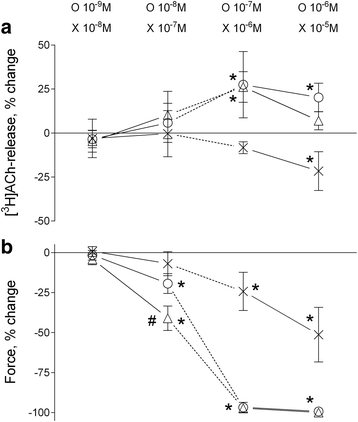Interactions between glycopyrronium and indacaterol on cholinergic neurotransmission and contractile response in bovine trachealis
- PMID: 28754132
- PMCID: PMC5534043
- DOI: 10.1186/s12931-017-0627-5
Interactions between glycopyrronium and indacaterol on cholinergic neurotransmission and contractile response in bovine trachealis
Abstract
Background: Muscarinic-receptor antagonists and β-adrenoceptor agonists are used, alone or in combination, as first-line treatment for chronic obstructive pulmonary disease. Both drugs decrease airway smooth muscle tone by post-junctional mechanisms but they may have opposing effects on pre-junctional acetylcholine (ACh)-release.
Methods: We studied the effects of the muscarinic-receptor antagonist glycopyrronium (GLY), the β-adrenoceptor agonist indacaterol (IND) and their combination on electrically-induced ACh-release and contractile response in isolated bovine trachealis. Data were analyzed by paired t-test and analysis of variance for repeated or independent measures with Newmann-Keuls post-hoc test when appropriate.
Results: GLY 10-8 M decreased contractile response by 19 ± 6% (p = 0.010) without altering ACh-release. GLY 10-7 M and 10-6 M almost abolished contractile responses even if the ACh-release was increased by 27 ± 19% (p < 0.001) and 20 ± 8% (p = 0.004), respectively. IND 10-7 M had no significant effects on contractile response and ACh-release, whereas IND 10-6 M reduced contractile response by 24 ± 12% (p = 0.002) without altering ACh-release. IND 10-5 M decreased contractile response by 51 ± 17% (p < 0.001) and ACh-release by 22 ± 11% (p = 0.004). Co-incubation with GLY 10-8 M and IND 10-7 M did not alter ACh-release but inhibited contractile response by 41 ± 8% (p < 0.001). The latter effect was greater than with GLY 10-8 M, or IND 10-7 M, or IND 10-6 M given separately (p < 0.001 for all). The increment of ACh-release caused by GLY was attenuated by IND 10-5 M, though this did not affect contractile response.
Conclusions: At equimolar concentration, GLY alone attenuates airway smooth muscle contraction more than IND, despite an increased ACh-release. Combination of GLY with IND at submaximal concentrations has more than additive effect suggesting a synergistic post-junctional effect. Adding GLY to IND provides a greater inhibitory effect on airway smooth muscle contraction than increasing IND concentration.
Keywords: Acetylcholine; Airway smooth muscle; Long-acting muscarinic antagonist; Long-acting β-adrenoceptor agonist.
Conflict of interest statement
Ethics approval
Bovine tracheas were obtained, after permissions, from BLM Carni S.r.l., via Brughiera 10, 16030 Tribogna, Genoa and Fasce Gian Mario Ditta Individuale, via Recroso 241/bis, 16024 Lumarzo, Genoa. Ethical approval was not required because none of the authors was involved in the care or killing of the animals. Bovine care and slaughtering procedures were done according to the Italian law.
Consent for publication
Not applicable.
Competing interests
M.B. and G.B. have no competing interests to declare. V.B. has acted in a consultancy capacity and given lectures and has received fees from Boehringer Ingelheim, Dompé, GSK, Menarini, Novartis, AstraZeneca, Almirall. V.B. institution has received research support from Novartis and Chiesi.
Publisher’s Note
Springer Nature remains neutral with regard to jurisdictional claims in published maps and institutional affiliations.
Figures




Similar articles
-
Pharmacological characterisation of the interaction between glycopyrronium bromide and indacaterol fumarate in human isolated bronchi, small airways and bronchial epithelial cells.Respir Res. 2016 Jun 13;17(1):70. doi: 10.1186/s12931-016-0386-8. Respir Res. 2016. PMID: 27296533 Free PMC article.
-
Effects of (a Combination of) the Beta2-Adrenoceptor Agonist Indacaterol and the Muscarinic Receptor Antagonist Glycopyrrolate on Intrapulmonary Airway Constriction.Cells. 2021 May 18;10(5):1237. doi: 10.3390/cells10051237. Cells. 2021. PMID: 34069899 Free PMC article.
-
Effects of indacaterol on the LPS-evoked changes in fluid secretion rate and pH in swine tracheal membrane.Pflugers Arch. 2021 Jun;473(6):883-896. doi: 10.1007/s00424-021-02560-z. Epub 2021 May 24. Pflugers Arch. 2021. PMID: 34031755 Free PMC article.
-
Role of dual bronchodilators in COPD: A review of the current evidence for indacaterol/glycopyrronium.Pulm Pharmacol Ther. 2017 Aug;45:19-33. doi: 10.1016/j.pupt.2017.04.002. Epub 2017 Apr 4. Pulm Pharmacol Ther. 2017. PMID: 28389258 Review.
-
Indacaterol/glycopyrronium: a dual bronchodilator for COPD.Drug Discov Today. 2018 Jan;23(1):196-203. doi: 10.1016/j.drudis.2017.10.015. Epub 2017 Oct 24. Drug Discov Today. 2018. PMID: 29079130 Review.
References
-
- Wessler I, Bender H, Härle P, Höhle KD, Kirdorf G, Klapproth H, et al. Release of [3H] acetylcholine in human isolated bronchi. Effect of indomethacin on muscarinic autoinhibition. Am J Respir Crit Care Med. 1995;151(4):1040–1046. - PubMed
Publication types
MeSH terms
Substances
LinkOut - more resources
Full Text Sources
Other Literature Sources

